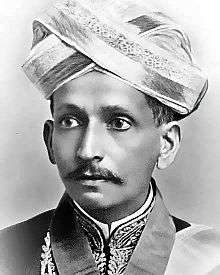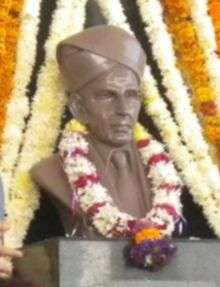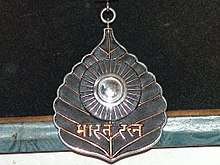M. Visvesvaraya
| Sir M. Vishweshvaraya KCIE, FASc | |
|---|---|
| Mokshgundom Visvesvaraya | |
 Sir M. Visvesvaraya in his 30s | |
| 19th Diwan of the Mysore Kingdom | |
|
In office 1912–1918 | |
| Monarch | Krishna Raja Wadiyar IV |
| Preceded by | T. Ananda Rao |
| Succeeded by | M. Kantaraj Urs |
| Personal details | |
| Born |
15 September 1861 Muddenahalli, Chikkaballapura, Kingdom of Mysore, British India (now Karnataka), India |
| Died |
12 April 1962 (aged 101) Bangalore, Karnataka, India |
| Nationality | Indian |
| Alma mater | College of Engineering Pune |
| Profession |
Civil Engineer, Politician |
Sir Mokshagundam Vishweshvaraya KCIE, FASc[1] also spelled as Sir Mokshagondam Vishweshwarayya, popularly known as Sir MV (15 September 1860 – 12 April 1962)[2][3] was an Indian Chief civil engineer, scholar, statesman, politician [4] and the 19th Diwan (Governor) of Mysore, who served from 1912 to 1919[5]. He received India's highest honour, the Bharat Ratna, in 1955. He was knighted as a Knight Commander of the British Indian Empire (KCIE) by King George V for his contributions to the public good. 15 September is celebrated as Engineer's Day in India in his memory. He is held in high regard as a pre-eminent Engineer of India. He was chief engineer responsible for the construction of the Krishna Raja Sagara dam in the North-West suburb of Mysuru city and chief engineer of the flood protection system for the city of Hyderabad.[6]
Early years
Mokshagundam Vishweshvaraya was born on 15 September 1861 into a Telugu[7] speaking Brahmin family belonging to the Mulukanadu subcaste and the Smartha sect.[8] His father, Mokshagundam Srinivasa Sastry, was a school teacher and a noted Sanskrit scholar,[9] while his mother, Venkatalakshamma, was a homemaker. Visvesvaraya was born in Muddenahalli village (now located in Chikkaballapura District, but part of Kolar district at the time of his birth) in the princely state of Mysore (now Karnataka), India.[10]
Visvesvaraya lost his father at the age of 12. He attended primary school in Chickballapur and high school in Bangalore. In 1881, he received a BA degree from Central College, Bangalore, (then an affiliate of the University of Madras), a rare accomplishment in the India of that era. He then enrolled at College of Engineering, Pune.[11][12] He received LCE (Licenciate in Civil Engineering) equivalent to DCE (Diploma in Civil Engineering) from the University of Bombay to which the College of Engineering was affiliated.
Career
Visvesvaraya took a job with the PWD of Bombay and later was invited to join the Indian Irrigation Commission. He implemented an extremely intricate system of irrigation in Deccan.
He designed and patented a system of automatic weir water floodgates that were first installed in 1903 at Khadakvasla Reservoir near Pune. These gates were employed to raise flood supply level of storage in reservoir to the highest level likely to be attained without causing any damage to the dam. Based on the success of these gates, the same system was installed at the Tigra Dam in Gwalior and Krishna Raja Sagara (KRS) Dam in Mandya/Mysore, Karnataka.
In 1906–07, Government of India sent him to Aden to study water supply and drainage systems. The project prepared by him was implemented in Aden successfully.[13]
Visvesvaraya achieved celebrity status when he designed a flood protection system for city of Hyderabad. He was instrumental in developing a system to protect Visakhapatnam port from sea erosion.[14]. This dam created the biggest reservoir in Asia when it was built.[15] Visvesvaraya gave his valuable technical advice for the location of Mokama Bridge over Ganga in Bihar. At the time, he was over 90 years old.[16][17]
He was called "Father of Modern Mysore State" . During his service with the government of Mysore State, he was responsible for founding of (under the patronage of the Mysore government) Mysore Soap Factory, Parasitoid Laboratory, Mysore Iron & Steel Works (now known as Visvesvaraya Iron and Steel Limited) in Bhadravathi, Sri Jayachamarajendra Polytechnic, Bangalore, Bangalore Agricultural University, State Bank of Mysore, Century Club, Mysore Chamber of Commerce (presently known as the Federation of Karnataka Chambers of Commerce & Industry (FKCCI) the apex Chamber of Commerce in Karnataka, University Visvesvaraya College of Engineering Bangalore and numerous other industrial ventures. He encouraged private investment in the industry during his tenure as Diwan of Mysore. He was instrumental in charting out the plan for road construction between Tirumala and Tirupati.[18][19][20]
He was known for sincerity, time management, and dedication to a cause. Bangalore Press and Bank of Mysore were established during his tenure. A very important part of his nature was his love for Kannada. He set up the Kannada Parishat for the upliftment of Kannada. He wanted seminars for Kannada lovers to be instituted and conducted in Kannada itself.[8]
Visvesvaraya is known to have designed and planned the entire area of Jayanagar in south Bangalore. The foundation of Jayanagar was laid in 1959. It was one of first planned neighbourhoods in Bangalore and, at the time, the largest in Asia. It is believed that locality, designed by Visvesvaraya, is one of the best-planned layouts in Asia.
Career timeline
- Joined service as assistant engineer in Bombay, 1885; served in Nasik, Khandesh and Pune
- Services lent to municipality of Sukkur in Sind, 1894: designed and carried out the water works of that Municipality, 1895
- Executive Engineer, Surat, 1896;
- Assistant Superintending Engineer, Pune, 1897–99; visited China and Japan, 1898
- Executive engineer for Irrigation, Pune, 1899
- Sanitary engineer, Bombay, member, Sanitary Board, 1901; gave evidence before Indian Irrigation Commission, 1901
- Designed and constructed automatic gates patented by him at Lake Fife Storage Reservoir; introduced a new system of irrigation known as the "Block System", 1903; represented the Bombay Government at the Simla Irrigation Commission, 1904; on special duty, 1905
- Superintending engineer, 1907; visited Egypt, Canada, USA, and Russia, 1908
- Services lent as consulting engineer, Hyderabad, to supervise and carry out engineering works in connection with the Musi floods, 1909
- Retired from British service, 1909
- Chief engineer and secretary to the government of Mysore, 1909
- Dewan of Mysore, PWD and Railway, 1913
- Board of directors of Tata Steel, 1927–1955[21][22][23]
Diwan of Mysore

After opting for voluntary retirement in 1908, he took a foreign tour to study industrialised nations. After, for a short period, he worked for the Nizam of Hyderabad, India. He suggested flood relief measures for Hyderabad town, which was under constant threat by the Musi river. During November 1909, Visvesvaraya was appointed as chief engineer of Mysore State. Further, during 1912, he was appointed as diwan (second minister) of the princely state of Mysore. He was diwan for seven years[5].
With the support of Krishnaraja Wodeyar IV, Maharaja of Mysore, Visvesvaraya made good contribution as diwan to the all-round development of Mysore state. Not only the achievements listed above, but many other industries and public works owe their inception or active nurturing to him.
He was instrumental in the founding of the Government Engineering College at Bangalore in 1917, one of the first engineering institutes in India[24]. This institution was later named the University Visvesvaraya College of Engineering after its founder. He commissioned several new railway lines in Mysore state.
Awards and honours

Visvesvaraya was appointed a Companion of the Order of the Indian Empire (CIE) in 1911.[25] In 1915, while he was the Diwan of Mysore, Visvesvaraya was knighted as a Knight Commander of the Order of the Indian Empire (KCIE) by the British for his myriad contributions to the public good.[26] After India attained independence, he was awarded the nation's highest honour, the Bharat Ratna, in 1955.[27] Sir M.V. was awarded honorary membership of the London Institution of Civil Engineers.[28] He was awarded a fellowship of the Indian Institute of Science (based in Bangalore). He was awarded several honorary doctoral degrees including D.Sc., LL.D., D.Litt. from eight universities in India. He was president of the 1923 session of the Indian Science Congress. He was the most popular person from Karnataka, in a newspaper survey conducted by Prajavani.
On 15 September 2018, to celebrate his 157th birthday anniversary Visvesvaraya was honored with Google Doodle.[29]
Recognition
Visvesvaraya has received recognition in many fields, most notably the education and the engineering sectors. Visvesvaraya Technological University which is based in Belagavi (to which most engineering colleges in Karnataka are affiliated) has been named in his honour, as well as prominent colleges like University Visvesvaraya College of Engineering, Bangalore, Sir M. Visvesvaraya Institute of Technology, Bangalore and Visvesvaraya National Institute of Technology, Nagpur.
College of Engineering, Pune, his alma mater, has erected a statue in his honour.[30]
The Visvesvaraya Industrial and Technological Museum in Bangalore is named in his honour.
Two metro stations in India, one in Bengaluru on the Purple Line (Sir M. Visvesvaraya Station, Central College), and another one in Delhi on the Pink Line (Sir Vishveshwaraiah Moti Bagh), have been named after him.[31]
Memorial at Muddenahalli

The Visvesvaraya National Memorial Trust manages a memorial of Visvesvaraya at his birthplace Muddenahalli. The memorial exhibits his awards, titles and personal belongings, including his living room, spectacles, cups, books and a block with which his visiting cards were printed. Models of the Krishna Raja Sagar dam, which Visvesvaraya designed and supervised the construction of, are exhibited. The memorial is adjacent to his house, which was refurbished and regarded as a temple by the locals.[32][33]
Works
- Visvesvaraya, M (1920), Reconstructing India, P. S. King & son, ltd, OCLC 2430680
- Visvesvaraya, M (1936), Planned economy for India, Bangalore: Bangalore Press, OCLC 19373044
- Visvesvaraya, M (1951), Memories of my working life, Bangalore, OCLC 6459729
- Visvesvaraya, M (1932), Unemployment in India; its causes and cure, Bangalore: The Bangalore Press, OCLC 14348788
- Visvesvaraya, M (1917), Speeches, Bangalore: Govt. Press, OCLC 6258388
- A Brief Memoir of my complete working life, Government Press, Bangalore, 1959
| Political offices | ||
|---|---|---|
| Preceded by T. Ananda Rao |
Diwan of Mysore (1912–1919) |
Succeeded by M. Kantaraj Urs |
References
- ↑ "Fellowship – Visvesvaraya, M." Indian Academy of Sciences. Archived from the original on 6 March 2018. Retrieved 5 March 2018.
- ↑ Sir M. Visvesvaraya | Sir MV | Karnataka Personalities Archived 27 January 2013 at the Wayback Machine.. Karnataka.com (1 October 2007). Retrieved 30 December 2013.
- ↑ Complete biography of Dr. M. Visvesvaraya Archived 21 October 2016 at the Wayback Machine. Retrieved on 14 October 2016
- ↑ "Opinion An unsentimental man of action".
- 1 2 "The Hindu : Diwans take over". www.thehindu.com. Retrieved 2018-09-16.
- ↑ "How M Visvesvaraya Made Hyderabad Flood Free: Lessons For Smart Cities". Archived from the original on 18 September 2016. Retrieved 15 September 2016.
- ↑ "Who is M. Visvesvaraya? Everything You Need to Know". Retrieved 15 September 2018.
- 1 2 Nath, Pandri (1987). Mokshagundam Visvesvaraya: life and work. Bharatiya Vidya Bhavan. p. 37,47,49,91.
- ↑ Karnataka News : Remembering Karnataka's icon – Sir. M. Vishveshvarayya Archived 28 September 2013 at the Wayback Machine.. The Hindu (15 September 2010). Retrieved 30 December 2013.
- ↑ Byappanahalli once belonged to Visvesvaraya's ancestors – Bangalore Mirror Archived 18 October 2016 at the Wayback Machine.
- ↑ Kannada Anubhava. Bangalore: Department of Kannada, RV College of Engineering. 2010.
- ↑ "Archived copy". Archived from the original on 29 September 2014. Retrieved 29 August 2014.
- ↑ Gupta, Jyoti Bhusan Das, ed. (2007). Science, Technology, Imperialism and War. History of Science, Philosophy and Culture in Indian Civilization. Volume XV, Part I. Pearson Longman. p. 247.
- ↑ "Visvesvaraya's services recalled". The Hindu. 16 September 2006. Archived from the original on 10 May 2011. Retrieved 21 March 2011.
- ↑ Husain, Dildar (1966) An Engineering Wizard of India, Institution of Engineers (India) AP, Hyderabad.
- ↑ "Sir's inimitable vision".
- ↑ "THE JEWEL OF KARNATAKA". Archived from the original on 17 September 2016. Retrieved 16 September 2016.
- ↑ Sree Venkateswara Ghat Rd, Tirupati, Andhra Pradesh Archived 7 February 2016 at the Wayback Machine.
- ↑ Tirumala-Tirupati Ghat Roads Tirumala ghat roads
- ↑ "Tirumala to Tirupati ghat road". Archived from the original on 9 August 2017. Retrieved 13 October 2016.
- ↑ Sinha, Arindam (23 September 2014). "How a relentless R&D approach propelled Tata Steel to the zenith". The Financial Express. Archived from the original on 26 September 2015. Retrieved 26 July 2015.
- ↑ "44th Sir M Visvesvaraya Memorial Lecture by Dr. Amit Chatterjee" (PDF). Advancement of Engineering in India in New Millennium: A Compilation of Memorial Lectures presented in Indian Engineering Congresses (2001–2010): 12–13. December 2012. Archived (PDF) from the original on 17 March 2016. Retrieved 26 July 2015.
- ↑ Mahanti, Subodh. "The Most Celebrated Indian Engineer: Mokshagundam Visvesvaraya". Vigyan Prasar Science Portal. Archived from the original on 4 June 2007. Retrieved 26 July 2015.
- ↑ "Why India celebrates Engineers Day on Visvesvaraya's birth anniversary". The Economic Times. 2018-09-15. Retrieved 2018-09-16.
- ↑ "No. 28559". The London Gazette. 8 December 1911. p. 9363.
- ↑ "No. 29180". The London Gazette (Supplement). 1 June 1915. p. 5329.
- ↑ "Padma Awards Directory (1954–2007)" (PDF). Ministry of Home affairs. Archived from the original (PDF) on 10 April 2009. Retrieved 26 November 2010.
- ↑ "Welcome to Chikballapur District – Visvesvaraya". Chikballapur.nic.in. Archived from the original on 20 September 2010. Retrieved 11 August 2010.
- ↑ "Google doodle marks engineer M Visvesvaraya's 157th birth anniversary". The Time of India. Retrieved 15 September 2018.
- ↑ "Engineer's Day 2010 Celebrations". Today24news. 15 September 2010. Archived from the original on 5 April 2012. Retrieved 28 October 2011.
- ↑ "Delhi gets metro station named after Sir. M Visveswaraya". The Hindu. 6 August 2018. Retrieved 9 August 2018.
- ↑ "MV memorabilia give glimpses of a genius". DNA India. 13 August 2011. Archived from the original on 9 March 2012. Retrieved 28 October 2011.
- ↑ Kamath, Vijesh (8 September 2009). "For locals, Vivesvaraya's house is a place of worship". Deccan Herald. Archived from the original on 14 November 2012. Retrieved 28 October 2011.
External links
| Wikiquote has quotations related to: M. Visvesvaraya |
| Wikimedia Commons has media related to Mokshagundam Visvesvaraiah. |
| Wikisource has original text related to this article: |
